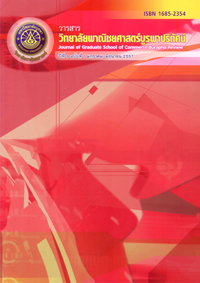การใช้สารสนเทศทางการบัญชีเพื่อการวางแผน การควบคุมภายในของธุรกิจ อุตสาหกรรม POLYETHYLENE FOAM PRODUCTION: กรณีศึกษา บริษัท เอบีซี (ประเทศไทย) จำกัด
Main Article Content
Abstract
การค้นคว้าแบบอิสระเรื่อง การใช้สารสนเทศทางการบัญชีเพื่อการวางแผน การควบคุมภายในของธุรกิจ อุตสาหกรรม POLYETHYLENE FOAM PRODUCTTION: กรณีศึกษา บริษัท เอบีซี (ประเทศไทย) จำกัด โดยมีวัตถุประสงค์เพื่อการใช้สารสนเทศเพื่อการควบคุมภายในของบริษัท เพื่อเป็นประโยชน์ในการพัฒนาปรับปรุงระบบ การควบคุมภายในของบริษัทต่อไป วิธีการศึกษาเป็นการเก็บรวบรวมข้อมูลจากการสังเกต และสัมภาษณ์ ผู้บริหาร ของกิจการจำนวน 4 ท่าน ตามกรอบการการควบคุมภายใน พร้อมวิเคราะห์และเสนอแนวทางแก้ไข ในแต่ละวงจรการค้า ซึ่งมีทั้งหมด 2 วงจร อันได้แก่ วงจรรายจ่าย และวงจรการผลิต
จากการศึกษาพบว่า กิจการมีการใช้แนวทางการใช้ระบบสารสนเทศที่มีประสิทธิภาพแต่ละวงจรการค้า แบ่งตามประเภทกิจกรรม โดยในวงจรรายจ่ายมีการใช้แนวทางการควบคุมภายในสำหรับกิจกรรมต่าง ๆ คือ ในเรื่องทั่วไป ระบบการจัดซื้อ ระบบการจ่ายชำระหนี้ ด้านระบบเจ้าหนี้ และการควบคุมเงินสดย่อย ส่วนใหญ่มีการใช้ระบบสารสนเทศ ที่ดีและการปฏิบัติในการควบคุมภายในแล้ว และสำหรับวงจรการผลิตซึ่งเป็นวงจรหลักในการดำเนินธุรกิจและ มีความสำคัญอย่างยิ่ง ต้องมีการใช้ระบบสารสนเทศในส่วนการผลิตสินค้าร่วมกับการวางระบบการควบคุมภายในที่ดี ได้แก่ การผลิต ระบบคลังสินค้า การจ่ายและการจัดเก็บวัสดุ ในส่วนของสินค้าสำเร็จและวัตถุดิบ ส่วนที่ต้องมีการปรับปรุง การใช้ระบบสารสนเทศทางการบัญชีร่วมในการการควบคุมภายใน ได้แก่ ในส่วนของการผลิตสินค้าระหว่างการผลิต
อย่างไรก็ตามถึงแม้ว่าผลการประเมินการใช้ระบบสารสนเทศของกิจกรรมภายในวงจรทั้ง 2 ส่วนใหญ่มีการใช้ ระบบสารสนเทศและการควบคุมที่ดี แต่ยังมีความเสี่ยงที่อาจจะเกิดขึ้นจากกิจกรรมบางอย่างที่ไม่มีการปฏิบัติให้สอดคล้อง กับแนวทางการใช้ระบบสารสนเทศและการควบคุมภายในที่ดีคือ การตรวจสอบการปฏิบัติงานเกี่ยวกับเอกสาร การส่งเสริมประสิทธิภาพของพนักงานในหน่วยงาน การควบคุมดูแลสินค้า ซึ่งกิจการควรมีการปรับปรุงระบบการควบคุม ภายในเพื่อลดความเสี่ยงที่มีอยู่ในปัจจุบัน
ACCOUNTING INFORMATION USAGE FOR INTERNAL CONTROL PLANNING OF POLYETHYLENE FOAM PRODUCTION INDUSTRIAL BUSINESS: A CASE VSTUDY OF ABC (THAILAND) CO., LTD.
Jaturong Ytamakul, Sakchai Chanroung and Ornicha Pothong
Graduate School of Commerce, Burapha University, Chon Buri 20131, Thailand
This research entitled “The Accounting Information Usage for Internal Control Planning of Polyethylene Foam Production Business: A Case Study of ABC (Thailand) Co., Ltd.” has the objective to study the accounting information usage for internal control planning of a case study company for the benefits of improving the company’s internal control system in the future. Data were collected from observations and interviews with 4 business owners, according to the internal control framework. This study also analyzes and suggests guidelines for corrections in each trade cycle, which has 2 cycles, namely, expense cycle and production cycle.
This study finds that the business uses an efficient information system for each business cycle categorized by type of activity. In the expense cycle, there is a way for internal control in various activities, like general matters, procurement system, debt payment system, account payable system, and petty cash control. Mostly there are good information system usage and practice. As for the production cycle, which is the main cycle in the business operation and is highly important, there must be good usage of information system in the production together with good internal control system planning like production, inventory, and materials dispensing and storing. As for finished goods and raw materials, things that must be improved regarding good usage of information system in the production together with good internal control system planning are work-in-progress production.
However, even two information system usage evaluations of internal activities have good information system and good control, there still is potential risk that may result from other activities that are not consistent with good information system usage and good internal control. For example, the inspection of documentation, efficiency improvement for employees in the department, and inventory control. The business should improve the internal control system to reduce the risk that exists at present.
Article Details
The owner of the article does not copy or violate any of its copyright. If any copyright infringement occurs or prosecution, in any case, the Editorial Board is not involved in all the rights to the owner of the article to be performed.

